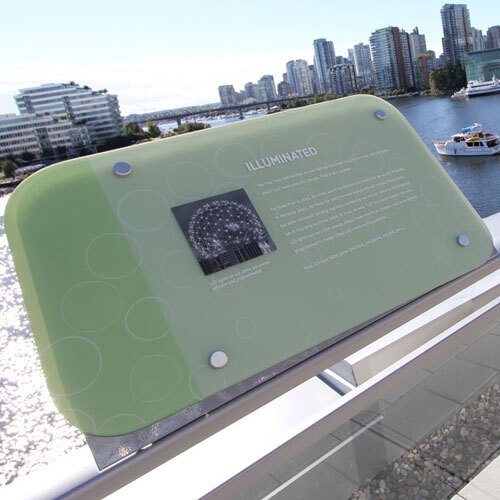
In-house design team at Science World, led by Carolina Becerra, uses design to engage and inform visitors on the science centre’s new green technologies.
Design Challenge
One of Vancouver’s most popular museums recently underwent a renovation that, for passersby in False Creek, would be hard to miss. The most significant impacts of Science World’s renovation, however, isn’t obvious at street level.
Science World is a not-for-profit interactive science centre dedicated to promoting science in British Columbia. As such, they’re always in pursuit of ways to implement sustainable practices. For their communications and exhibits, this includes considering what and how materials are used, suppliers they choose to work with, and how projects can be reused or recycled. The renovation offered an opportunity to use more green technologies to conserve energy and water and to reduce waste.
The building incorporates fascinating technology. A sewer heat recovery system heats the floor and an evacuated tube solar thermal system provides hot water. Special glass for their windows uses glazing and coating that reduce infrared and ultraviolet lights and control solar heat gain. (Visitors can play with this technology at the museum.) Building Integrated Photovoltaics were installed as part of the windows to convert light into electric energy. (How cool is that?!) A rooftop garden gives their bees a home and helps improve the climate both inside the building and in the city. Lastly, their infamous dome’s lights are now bright, low-energy, long-lasting LEDs providing lovely colours for our enjoyment.
The new sustainability measures and technologies needed to be communicated to their visitors of all ages, including parents, donors and scientists. With the potential to simply be technical jargon, the challenge for Science World’s designers, led by graphics manager/creative director Carolina Becerra, was to create signage that explained in a simple, inviting and understandable way the green technologies implemented during the renovation. The signage needed to attract attention without competing with all the other information in the science centre. 
Strategy & Solutions
It was a challenge writing copy that distilled complex technologies into clear, concise language. The in-house team used simple drawings to illustrate the technology and, to attract attention to the signage without competing with other displays, they chose a bright green outside of their corporate palette.
The team looked for durable substrates that could be repurposed and/or recycled when the signs are no longer needed. They planned to use recycled plastics that could be recycled again, but a major budget cut meant they had to use Lexan, a highly durable, scratch-resistant, clear polycarbonate that can be recycled. The design deliberately maximized the use of the material. The signage was produced, digitally printed and installed by local sign-maker John Peachey. The team declined a suggestion to have posters and pamphlets made for additional information about the technologies, opting instead to point interested visitors to their website.

Result
Science World’s visitors are quite impressed and excited by the new technologies, and are eager to learn more about them. The signage teaches them about the environmental impacts of our daily activities, like flushing the toilet, and brings attention to the myriad ways individuals can preserve the environment. This awareness leads to change. Science World is now a model for local innovation and has opened a dialogue to learn more about sustainable practices. We hope other institutions and graphic designers will be inspired by Science World’s leadership.
PDF Download Case Study: Science World
Credits: www.scienceworld.ca
Strategy, Art Direction: Carolina Becerra CGD
Project Management, Design, Illustration: Madeline Koeberling
Research: Daniel Devora
Copywriting: Amanda McCuaig, Pamela Findling, Barb Adamski and Hana Dethlefsen
Production: Madeline Koeberling and Brooks Amos
Printing: John Peachey and Associates
—
Looking to contribute to the national conversation and elevate the Canadian design communications profession? Submit your article to our editorial team: designcurrency@descan.ca